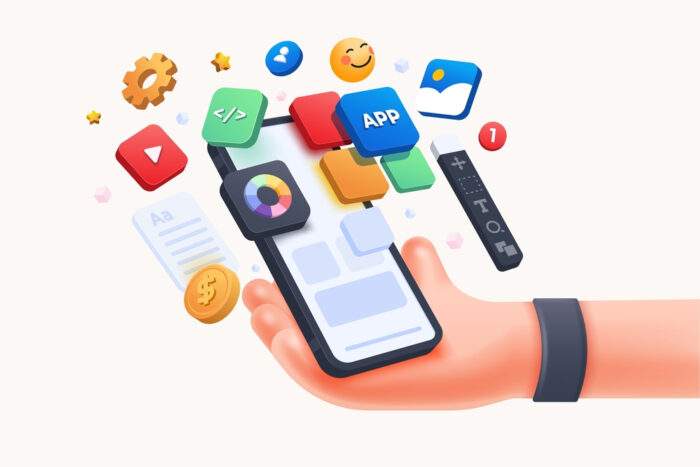Why Flutter is Consider as a Game Changer in Application Development?

Mobile applications have assumed unprecedented importance in today’s digital landscape, spearheading the advancements in app store technologies, exemplified by the App Store and Play Store.
Despite their ease and convenience, the decision to develop a mobile app remains challenging. Nevertheless, there is a solution that allows you to construct an app for all major platforms simultaneously. By doing so, you can achieve cost-effectiveness, reduce the need for extensive developer resources, and eliminate the complexities of mastering multiple coding languages. That solution is Flutter!
Introduced in 2017, Flutter application development is the latest addition to cross-platform app development frameworks. In remarkably short order, it has established itself as the premier framework and a widely adopted SDK toolkit. Flutter empowers developers to create mobile applications and expand their reach to desktop and web platforms, all from a single codebase.
What is Flutter?
Flutter is an open-source framework developed by Google that has revolutionized how we create cross-platform mobile applications. Introduced in 2017, Flutter has rapidly gained popularity among developers for its ability to build high-quality, natively compiled mobile, web, and desktop apps from a single codebase. At its core, Flutter employs the Dart programming language, known for its simplicity and efficiency.
Its widget-based architecture sets Flutter apart, enabling developers to craft rich and interactive user interfaces by assembling customizable widgets. Moreover, Flutter’s hot reload feature significantly expedites the development process, allowing real-time visualization of code changes making it an invaluable tool for modern app development.
How Does Flutter Work?
Flutter combines its unique architecture, the Dart programming language, and a set of pre-designed widgets to create cross-platform mobile applications. At its heart, Flutter utilizes a reactive framework where everything is considered a widget, from basic UI elements like buttons and text to complex layouts and animations. Developers compose these widgets to build the app’s user interface, allowing for a highly customizable and responsive design.
One of Flutter’s key features is its “hot reload” capability, which enables developers to see immediate results when making code changes. This rapid development cycle significantly speeds up the debugging and refinement process, making creating polished and feature-rich applications easier. Under the hood, Flutter compiles Dart code to native machine code, ensuring excellent performance and enabling apps to run seamlessly on Android and iOS devices. This approach simplifies the development process and results in a consistent and native-like user experience across different platforms.
Why Flutter is a Game-Changer in Application Development?
Flutter has emerged as a game-changer in application development for several compelling reasons:
Single Codebase for Multiple Platforms
Flutter’s game-changing application development aspect is its ability to utilize a “Single Codebase for Multiple Platforms.” Traditionally, developing applications for both Android and iOS necessitated the creation and maintenance of distinct codebases, which was not only time-consuming but also resource-intensive. Flutter addresses this challenge by enabling developers to write code once and seamlessly deploy it across various platforms. This transformative approach streamlines the development process, significantly reducing the effort required to reach a broader audience. It empowers businesses and developers to efficiently create cross-platform applications, saving time and resources.
Moreover, the consistency achieved through a single codebase ensures that the user experience remains uniform across different devices, enhancing brand image and user satisfaction. This efficiency and cost-effectiveness are core reasons why Flutter is seen as a game-changer in the world of application development, enabling businesses to stay competitive and agile in a dynamic digital landscape.
Native-Like Performance
Native-Like Performance” is a pivotal factor in why Flutter stands out as a game-changer in application development. Flutter’s unique approach to compiling Dart code into native machine code ensures that applications built with Flutter perform with exceptional speed and responsiveness. Unlike cross-platform frameworks that rely on interpreters or web views, Flutter’s direct compilation to native code harnesses the full power of the underlying device, whether an Android phone or an iOS device. This means that Flutter apps not only look and feel native but also exhibit the same level of performance and fluidity as applications built using platform-specific tools. Users experience faster load times, smooth animations, and responsive interactions, contributing to a high-quality and satisfying user experience. In essence, Flutter combines the efficiency of cross-platform development with the performance of native apps, offering developers the best of both worlds and setting a new standard for application development.
Expressive UI
Expressive UI” is a critical element contributing to Flutter’s status as a game-changer in application development. Flutter offers various pre-designed and customizable widgets that allow developers to create stunning and highly interactive user interfaces. These widgets cover everything from basic elements like buttons and text inputs to complex layouts and animations. What sets Flutter apart is the sheer variety of widgets and the ease with which they can be combined and tailored to meet specific design and functionality requirements.
Flutter’s widget-based architecture empowers developers to craft pixel-perfect UIs that faithfully replicate the design vision across different platforms. The consistency achieved in UI design is crucial for branding and user satisfaction, as it ensures that the app looks and behaves consistently, whether on an Android phone or an iOS device.
Moreover, Flutter encourages creativity in UI design by allowing developers to experiment with animations, transitions, and intricate layouts. The result is visually appealing and highly engaging applications that captivate users and set a new standard for user experience.
Hot Reload
The “Hot Reload” feature in Flutter is a game-changer in application development and one of its most celebrated attributes. It allows developers to witness the real-time effects of code changes as they make them without recompiling or restarting the entire application. This capability greatly accelerates the development process, enhancing productivity and creativity.
With Hot Reload, developers can experiment, iterate, and fine-tune their code, UI, and features on the fly. They can instantly see how changes affect the app’s appearance and behavior, making spotting and resolving issues easier. This rapid development cycle reduces debugging time and fosters a more dynamic and collaborative development environment.
Furthermore, Hot Reload encourages a high degree of agility in development, enabling teams to respond quickly to user feedback, design tweaks, and evolving requirements. The immediate feedback loop is invaluable for achieving a polished and user-friendly application, making Flutter an appealing choice for businesses and developers aiming to create top-tier mobile apps efficiently. Hot Reload embodies Flutter’s commitment to speeding up the development process, contributing significantly to its reputation as a game-changer in application development.
Open-source and Active Community
The combination of an open-source framework and a highly active developer community lies at the heart of why Flutter is a game-changer in application development. Flutter’s open-source nature means it’s freely accessible to developers worldwide, encouraging collaboration and innovation. However, what truly sets Flutter apart is the passionate and engaged community that has rallied around it. This community is a wellspring of shared knowledge, resources, and support, making Flutter an even more formidable tool for developers.
The active Flutter community contributes to its growth and evolution in several ways. First, it continuously expands the ecosystem by creating a wealth of packages, plugins, and libraries that extend Flutter’s functionality. This extensive repository of pre-built solutions allows developers to accelerate their projects and tap into a rich array of tools. Moreover, the community-driven development model ensures that Flutter is continuously updated, with bug fixes and feature enhancements released regularly.
One of the most significant advantages of this active community is the rapid problem-solving and knowledge-sharing it facilitates. Developers can seek help, share insights, and collaborate on projects, fostering an environment of learning and mutual support. The accessibility of Flutter, combined with this communal spirit, democratizes mobile app development, enabling individuals and organizations to harness its potential.
Consistent Design Across Platforms
Consistent Design Across Platforms” is a pivotal aspect of why Flutter is a game-changer in application development. Historically, achieving a uniform look and feel across different platforms, such as Android and iOS, posed a significant challenge for developers. However, Flutter’s design philosophy prioritizes consistency, making it easier to create applications that maintain a cohesive and native-like user experience regardless of the underlying operating system.
Flutter achieves this consistency by offering a set of pre-designed widgets and a flexible widget-based architecture. These widgets adhere to Material Design guidelines for Android and Cupertino guidelines for iOS, ensuring that the app’s UI elements align with the platform’s native aesthetics and interactions. Furthermore, developers can customize these widgets to match their unique branding and design requirements while preserving platform-specific nuances.
This approach simplifies the development process by reducing the need for platform-specific code and design adjustments, which can be time-consuming and error-prone. As a result, businesses can establish a strong and recognizable brand presence while providing users with an intuitive and familiar interface, no matter which device they use.
Access to Native Features
Access to Native Features” is a key factor contributing to Flutter’s status as a game-changer in application development. While cross-platform development frameworks have historically struggled to provide comprehensive access to native device features, Flutter excels. It offers a rich ecosystem of plugins and packages that grant developers seamless access to a wide range of native capabilities and hardware features.
These plugins cover various functionalities, including camera access, geolocation services, sensors, authentication methods, and more. Flutter’s ability to bridge the gap between the framework and native code allows developers to harness the full potential of the underlying platforms without resorting to platform-specific development. This means that Flutter applications can deliver a truly native experience, utilizing the device’s hardware and software capabilities to their fullest extent.
Access to native features is especially crucial for creating feature-rich and high-performance applications. Flutter’s versatility empowers developers to build applications that can seamlessly interact with the device’s hardware, ensuring a smooth and responsive user experience. Whether integrating device-specific functionalities or leveraging platform-specific APIs, Flutter’s access to native features provides developers with the tools they need to create innovative and robust applications.
Cost-Effective Development
Cost-effective development” is a crucial aspect of why Flutter is considered a game-changer in application development. Building and maintaining applications for multiple platforms can be expensive, as it traditionally requires separate development teams and codebases. Flutter disrupts this model by allowing developers to write code once and deploy it across various platforms. This not only reduces development costs but also streamlines ongoing maintenance efforts.
Flutter’s cost-effectiveness is further enhanced by its efficiency. The framework’s hot reload feature enables rapid development and iteration, reducing development time and the associated costs. Developers can quickly test, refine, and optimize their applications, saving time and resources.
Additionally, Flutter’s open-source nature and active community contribute to cost savings. Businesses and developers can access many free resources, plugins, and third-party packages, eliminating the need for costly proprietary solutions. This accessibility democratizes application development, making it affordable for startups, small businesses, and independent developers to create high-quality cross-platform applications.
Cross-Platform Testing
Cross-platform testing” is a pivotal aspect of why Flutter is considered a game-changer in application development. Testing applications on multiple platforms with different operating systems, screen sizes, and resolutions in traditional development could be complex and time-consuming. However, Flutter simplifies this process significantly.
With Flutter’s single codebase approach, testing becomes inherently more efficient. Developers can write tests once and apply them across all target platforms, eliminating the need for platform-specific testing teams and test cases. This saves time and reduces the likelihood of inconsistencies and bugs that can arise when testing on different platforms.
Furthermore, Flutter’s widget-based architecture ensures that the user interface remains consistent across platforms. This design philosophy streamlines the testing of UI elements, as developers can confidently verify that widgets behave as expected on Android and iOS devices.
The hot reload feature in Flutter is also a valuable asset for testing. Testers and quality assurance teams can observe real-time changes in the application as developers make updates, allowing for faster identification and resolution of issues. This collaborative and iterative approach to testing enhances the overall quality of the application.
Conclusion
In conclusion, Flutter is a game-changer in application development for its transformative impact on creating cross-platform mobile applications. Its ability to streamline development with a single codebase, deliver native-like performance, and provide a consistent user experience across multiple platforms has revolutionized the industry. Features like Hot Reload, an extensive library of customizable widgets, and a vibrant open-source community have made Flutter an invaluable tool for developers and businesses. With Flutter, the future of application development looks promising as it continues to evolve and adapt to the ever-changing demands of the digital landscape.







